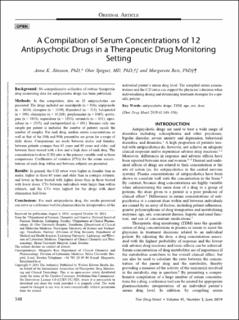| dc.description.abstract | Background:
No comprehensive collection of routine therapeutic drug monitoring data for antipsychotic drugs has been published.
Methods:
In this compilation, data on 12 antipsychotics are presented. The drugs included are amisulpride (n = 506), aripiprazole (n = 1610), clozapine (n = 1189), flupentixol (n = 215), haloperidol (n = 390), olanzapine (n = 10,268), perphenazine (n = 1065), quetiapine (n = 5853), risperidone (n = 3255), sertindole (n = 111), ziprasidone (n = 1235), and zuclopenthixol (n = 691). Because only one sample per patient is included, the number of patients equals the number of samples. For each drug, median serum concentrations as well as that of the 10th and 90th percentiles are given for a range of daily doses. Comparisons are made between males and females, between patients younger than 65 years and 65 years and older, and between those treated with a low and a high dose of each drug. The concentration-to-dose (C/D) ratio is the primary variable used in these comparisons. Coefficients of variation (CVs) for the serum concentrations of each drug within and between subjects are presented.
Results:
In general, the C/D ratios were higher in females than in males, higher in those 65 years and older than in younger subjects, and lower in those treated with higher doses than in those treated with lower doses. CVs between individuals were larger than within subjects, and the CVs were highest for the drugs with short elimination half-lives.
Conclusions:
For each antipsychotic drug, the results presented can serve as a reference tool for pharmacokinetic interpretation of the individual patient's serum drug level. The compiled serum concentrations and the C/D ratios can support the physician's decision when individualizing dosing and determining treatment strategies for a specific patient. | en_US |

